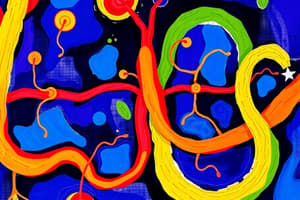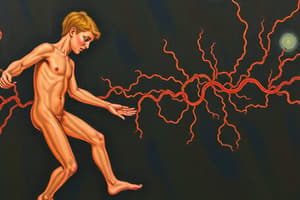Podcast
Questions and Answers
Which enzyme is primarily responsible for the breakdown of glycogen to glucose-1-phosphate?
Which enzyme is primarily responsible for the breakdown of glycogen to glucose-1-phosphate?
What prevents the simple reversal of glycolysis for glucose synthesis?
What prevents the simple reversal of glycolysis for glucose synthesis?
What is the effect of fructose 2,6-bisphosphate on the activity of phosphofructokinase-1?
What is the effect of fructose 2,6-bisphosphate on the activity of phosphofructokinase-1?
Which of the following statements about gluconeogenesis is true?
Which of the following statements about gluconeogenesis is true?
Signup and view all the answers
How does glucagon influence gluconeogenesis in the fasting state?
How does glucagon influence gluconeogenesis in the fasting state?
Signup and view all the answers
Which key enzyme in gluconeogenesis is influenced by hormonal control?
Which key enzyme in gluconeogenesis is influenced by hormonal control?
Signup and view all the answers
What is a major energy status indicator in cells during gluconeogenesis?
What is a major energy status indicator in cells during gluconeogenesis?
Signup and view all the answers
What is a key indicator of low energy status in cells that affects phosphofructokinase-1 activity?
What is a key indicator of low energy status in cells that affects phosphofructokinase-1 activity?
Signup and view all the answers
What is the role of ATP in regulating phosphofructokinase-1?
What is the role of ATP in regulating phosphofructokinase-1?
Signup and view all the answers
Which substrate ultimately enters gluconeogenesis after esterification with CoA?
Which substrate ultimately enters gluconeogenesis after esterification with CoA?
Signup and view all the answers
Feedback inhibition in metabolic pathways primarily affects which aspect of enzyme activity?
Feedback inhibition in metabolic pathways primarily affects which aspect of enzyme activity?
Signup and view all the answers
What is the functional significance of the bifunctional enzyme that has both kinase and phosphatase activities?
What is the functional significance of the bifunctional enzyme that has both kinase and phosphatase activities?
Signup and view all the answers
What type of biochemical reaction can glucogenic amino acids undergo to yield glucose?
What type of biochemical reaction can glucogenic amino acids undergo to yield glucose?
Signup and view all the answers
What role does glycerol play in metabolic processes?
What role does glycerol play in metabolic processes?
Signup and view all the answers
Which hormones are primarily involved in the regulation of gluconeogenesis?
Which hormones are primarily involved in the regulation of gluconeogenesis?
Signup and view all the answers
How does covalent modification affect pyruvate kinase in gluconeogenesis?
How does covalent modification affect pyruvate kinase in gluconeogenesis?
Signup and view all the answers
What is the immediate effect of glucagon on carbohydrate metabolism?
What is the immediate effect of glucagon on carbohydrate metabolism?
Signup and view all the answers
Which mechanism is NOT responsible for regulating enzyme activity in carbohydrate metabolism?
Which mechanism is NOT responsible for regulating enzyme activity in carbohydrate metabolism?
Signup and view all the answers
What is the role of fructose 2,6-bisphosphate in gluconeogenesis?
What is the role of fructose 2,6-bisphosphate in gluconeogenesis?
Signup and view all the answers
Which substrate is required for the enzyme pyruvate carboxylase to function?
Which substrate is required for the enzyme pyruvate carboxylase to function?
Signup and view all the answers
What happens during fasting regarding fatty acid metabolism?
What happens during fasting regarding fatty acid metabolism?
Signup and view all the answers
How do glucocorticoids affect glucose metabolism?
How do glucocorticoids affect glucose metabolism?
Signup and view all the answers
What is the impact of cAMP-dependent protein kinase in gluconeogenesis?
What is the impact of cAMP-dependent protein kinase in gluconeogenesis?
Signup and view all the answers
What primarily drives gluconeogenesis in the fasting state?
What primarily drives gluconeogenesis in the fasting state?
Signup and view all the answers
Which enzyme catalyzes the carboxylation of pyruvate to oxaloacetate in gluconeogenesis?
Which enzyme catalyzes the carboxylation of pyruvate to oxaloacetate in gluconeogenesis?
Signup and view all the answers
What is the role of biotin in the gluconeogenic pathway?
What is the role of biotin in the gluconeogenic pathway?
Signup and view all the answers
How does substrate supply influence gluconeogenesis despite hormonal signals?
How does substrate supply influence gluconeogenesis despite hormonal signals?
Signup and view all the answers
What substance does the liver primarily divert gluconeogenic-derived carbon into?
What substance does the liver primarily divert gluconeogenic-derived carbon into?
Signup and view all the answers
What type of reaction does phosphoenolpyruvate carboxykinase catalyze?
What type of reaction does phosphoenolpyruvate carboxykinase catalyze?
Signup and view all the answers
Which hormone is primarily associated with promoting gluconeogenesis?
Which hormone is primarily associated with promoting gluconeogenesis?
Signup and view all the answers
What is the function of GTP in the gluconeogenic process?
What is the function of GTP in the gluconeogenic process?
Signup and view all the answers
What mechanism allows gluconeogenesis to continue despite potential inhibition by insulin?
What mechanism allows gluconeogenesis to continue despite potential inhibition by insulin?
Signup and view all the answers
What is the primary role of gluconeogenesis in glucose homeostasis?
What is the primary role of gluconeogenesis in glucose homeostasis?
Signup and view all the answers
What metabolic process occurs when the liver synthesizes glycogen from gluconeogenic derivatives?
What metabolic process occurs when the liver synthesizes glycogen from gluconeogenic derivatives?
Signup and view all the answers
How does cortisol influence gluconeogenesis?
How does cortisol influence gluconeogenesis?
Signup and view all the answers
Which substrate contributes primarily to gluconeogenesis during long-term fasting?
Which substrate contributes primarily to gluconeogenesis during long-term fasting?
Signup and view all the answers
What happens to the glucose supply from the kidney after a prolonged fasting period?
What happens to the glucose supply from the kidney after a prolonged fasting period?
Signup and view all the answers
Which of the following is a key enzyme involved in gluconeogenesis?
Which of the following is a key enzyme involved in gluconeogenesis?
Signup and view all the answers
In which state is the supply of gluconeogenic substrates generally elevated?
In which state is the supply of gluconeogenic substrates generally elevated?
Signup and view all the answers
What role does lactate play in gluconeogenesis?
What role does lactate play in gluconeogenesis?
Signup and view all the answers
Which metabolic condition would likely increase the demand for gluconeogenesis?
Which metabolic condition would likely increase the demand for gluconeogenesis?
Signup and view all the answers
Which tissue is the primary site for gluconeogenesis?
Which tissue is the primary site for gluconeogenesis?
Signup and view all the answers
What is feedback inhibition in the context of gluconeogenesis?
What is feedback inhibition in the context of gluconeogenesis?
Signup and view all the answers
What primary factor determines the rate of hepatic gluconeogenesis?
What primary factor determines the rate of hepatic gluconeogenesis?
Signup and view all the answers
Which component has the least influence on the transport of gluconeogenic amino acids by the liver?
Which component has the least influence on the transport of gluconeogenic amino acids by the liver?
Signup and view all the answers
During exercise, what is the role of lactate that is produced by glycolysis?
During exercise, what is the role of lactate that is produced by glycolysis?
Signup and view all the answers
What happens to amino acids during gluconeogenesis in terms of first-pass metabolism by the liver?
What happens to amino acids during gluconeogenesis in terms of first-pass metabolism by the liver?
Signup and view all the answers
What is the primary effect of glucagon on gluconeogenesis?
What is the primary effect of glucagon on gluconeogenesis?
Signup and view all the answers
Which metabolic response is most likely triggered by low insulin levels?
Which metabolic response is most likely triggered by low insulin levels?
Signup and view all the answers
What significant change occurs regarding glycerol uptake by the liver during gluconeogenesis?
What significant change occurs regarding glycerol uptake by the liver during gluconeogenesis?
Signup and view all the answers
What role does the oxidative capacity of the liver play in gluconeogenesis?
What role does the oxidative capacity of the liver play in gluconeogenesis?
Signup and view all the answers
What is the primary effect of growth hormone on glucose uptake in muscle tissue?
What is the primary effect of growth hormone on glucose uptake in muscle tissue?
Signup and view all the answers
How do glucocorticoids influence insulin action in the body?
How do glucocorticoids influence insulin action in the body?
Signup and view all the answers
What is the main consequence of epinephrine and norepinephrine on insulin release?
What is the main consequence of epinephrine and norepinephrine on insulin release?
Signup and view all the answers
Which of the following statements about glucokinase activity in the liver is correct?
Which of the following statements about glucokinase activity in the liver is correct?
Signup and view all the answers
What characteristic of hexokinase distinguishes it from glucokinase?
What characteristic of hexokinase distinguishes it from glucokinase?
Signup and view all the answers
What is the primary role of glucocorticoids in carbohydrate metabolism?
What is the primary role of glucocorticoids in carbohydrate metabolism?
Signup and view all the answers
Which of the following compounds can activate phosphofructokinase-1 aside from insulin?
Which of the following compounds can activate phosphofructokinase-1 aside from insulin?
Signup and view all the answers
In the context of carbohydrate metabolism, what role does glucagon play during fasting?
In the context of carbohydrate metabolism, what role does glucagon play during fasting?
Signup and view all the answers
Which of the following conditions would most likely lead to increased activity of pyruvate carboxylase?
Which of the following conditions would most likely lead to increased activity of pyruvate carboxylase?
Signup and view all the answers
What is the effect of elevated acetyl-CoA levels on pyruvate dehydrogenase?
What is the effect of elevated acetyl-CoA levels on pyruvate dehydrogenase?
Signup and view all the answers
What may inhibit gluconeogenesis in a fed state?
What may inhibit gluconeogenesis in a fed state?
Signup and view all the answers
Which compound serves as a repressor of hexokinase activity?
Which compound serves as a repressor of hexokinase activity?
Signup and view all the answers
Which of the following is NOT a known activator of pyruvate kinase?
Which of the following is NOT a known activator of pyruvate kinase?
Signup and view all the answers
Which factor primarily regulates glucose-6-phosphatase activity during fasting?
Which factor primarily regulates glucose-6-phosphatase activity during fasting?
Signup and view all the answers
What is the impact of high levels of ATP on phosphofructokinase-1 activity?
What is the impact of high levels of ATP on phosphofructokinase-1 activity?
Signup and view all the answers
What effect does glucagon have on pyruvate kinase during gluconeogenesis?
What effect does glucagon have on pyruvate kinase during gluconeogenesis?
Signup and view all the answers
Which of the following best describes the relationship between glucagon and cAMP concentrations?
Which of the following best describes the relationship between glucagon and cAMP concentrations?
Signup and view all the answers
Which substrate is essential for the activation of pyruvate carboxylase in gluconeogenesis?
Which substrate is essential for the activation of pyruvate carboxylase in gluconeogenesis?
Signup and view all the answers
What is the primary metabolic change occurring during fasting that affects gluconeogenesis?
What is the primary metabolic change occurring during fasting that affects gluconeogenesis?
Signup and view all the answers
How do glucocorticoids affect gluconeogenesis compared to insulin?
How do glucocorticoids affect gluconeogenesis compared to insulin?
Signup and view all the answers
Which mechanism is primarily responsible for rapid changes in enzyme activity in carbohydrate metabolism?
Which mechanism is primarily responsible for rapid changes in enzyme activity in carbohydrate metabolism?
Signup and view all the answers
Which process is stimulated by elevated levels of cAMP in gluconeogenesis?
Which process is stimulated by elevated levels of cAMP in gluconeogenesis?
Signup and view all the answers
What is the role of glycerol during fasting in gluconeogenesis?
What is the role of glycerol during fasting in gluconeogenesis?
Signup and view all the answers
What key enzyme's regulation is influenced by fructose 2,6-bisphosphate levels?
What key enzyme's regulation is influenced by fructose 2,6-bisphosphate levels?
Signup and view all the answers
What primary factor influences gluconeogenesis in the fasting state?
What primary factor influences gluconeogenesis in the fasting state?
Signup and view all the answers
Which enzyme's reaction is considered endothermic in gluconeogenesis?
Which enzyme's reaction is considered endothermic in gluconeogenesis?
Signup and view all the answers
What role does biotin play in gluconeogenesis?
What role does biotin play in gluconeogenesis?
Signup and view all the answers
What is the expected effect on gluconeogenesis after a meal?
What is the expected effect on gluconeogenesis after a meal?
Signup and view all the answers
What product is derived from the decarboxylation of oxaloacetate in gluconeogenesis?
What product is derived from the decarboxylation of oxaloacetate in gluconeogenesis?
Signup and view all the answers
In which organ does gluconeogenesis primarily occur?
In which organ does gluconeogenesis primarily occur?
Signup and view all the answers
What is the consequence of elevated glucagon levels in the fasting state?
What is the consequence of elevated glucagon levels in the fasting state?
Signup and view all the answers
Which thermodynamic consideration is important in gluconeogenesis?
Which thermodynamic consideration is important in gluconeogenesis?
Signup and view all the answers
What happens to gluconeogenic-derived carbon in the liver during conditions of energy surplus?
What happens to gluconeogenic-derived carbon in the liver during conditions of energy surplus?
Signup and view all the answers
What type of signaling mechanism is primarily employed to regulate gluconeogenesis?
What type of signaling mechanism is primarily employed to regulate gluconeogenesis?
Signup and view all the answers
Match the following substances with their related metabolic processes:
Match the following substances with their related metabolic processes:
Signup and view all the answers
Match the following hormones with their functions in glucose metabolism:
Match the following hormones with their functions in glucose metabolism:
Signup and view all the answers
Match the following terms with their significance in homeostasis:
Match the following terms with their significance in homeostasis:
Signup and view all the answers
Match the following conditions with their respective effects on glucose:
Match the following conditions with their respective effects on glucose:
Signup and view all the answers
Match the following metabolic compounds with their roles in glucose regulation:
Match the following metabolic compounds with their roles in glucose regulation:
Signup and view all the answers
Match the following substances with their roles in gluconeogenesis:
Match the following substances with their roles in gluconeogenesis:
Signup and view all the answers
Match the following cycles with their descriptions:
Match the following cycles with their descriptions:
Signup and view all the answers
Match the following metabolic states with their characteristics:
Match the following metabolic states with their characteristics:
Signup and view all the answers
Match the following enzymes with their functions in gluconeogenesis:
Match the following enzymes with their functions in gluconeogenesis:
Signup and view all the answers
Match the following substrates with their gluconeogenic pathways:
Match the following substrates with their gluconeogenic pathways:
Signup and view all the answers
Study Notes
Gluconeogenesis:
- Gluconeogenesis is the process of creating glucose from non-carbohydrate sources.
- It is primarily carried out in the liver, with a small contribution from the kidneys.
- The main substrates for gluconeogenesis are glucogenic amino acids, lactate, glycerol, and propionate.
Bypassing Irreversible Reactions in Glycolysis
- There are three irreversible reactions in glycolysis that must be bypassed during gluconeogenesis:
- Hexokinase
- Phosphofructokinase
- Pyruvate kinase
Gluconeogenesis and Glycolysis: Reciprocal Regulation:
- Gluconeogenesis and glycolysis share the same pathway but in opposite directions.
- These pathways are reciprocally regulated to maintain homeostasis within the cell.
- Key enzymes for both pathways are regulated by a combination of:
- Hormonal control (covalent modification)
- Allosteric effects (substrate availability).
- This prevents futile cycling – the simultaneous synthesis and breakdown of the same molecules, wasting energy.
The Role of Fructose 2,6-Bisphosphate:
- Fructose 2,6-bisphosphate is a key regulator of both glycolysis and gluconeogenesis.
- It activates phosphofructokinase-1 (glycolysis) and inhibits fructose 1,6-bisphosphatase (gluconeogenesis).
- Its level is regulated by a bifunctional enzyme that acts as both a kinase and a phosphatase, controlled by the availability of fructose-6-phosphate.
Gluconeogenesis – An Integral Part of Glucose Homeostasis
- During fasting, gluconeogenesis is crucial for maintaining blood glucose levels.
- The liver uses lactate, glycerol, and amino acids as substrates for gluconeogenesis.
- The liver also releases glucogenic-derived carbon to augment the synthesis of glycogen, boosting its stores.
The importance of the Citric Acid Cycle in Gluconeogenesis:
- The citric acid cycle provides substrates for gluconeogenesis through the production of oxaloacetate.
- Propionate, a major precursor of glucose in ruminants, enters gluconeogenesis via the citric acid cycle.
Key Enzymes in Gluconeogenesis:
- Pyruvate carboxylase: Catalyzes the carboxylation of pyruvate to oxaloacetate using ATP and biotin as a coenzyme.
- Phosphoenolpyruvate carboxykinase: Catalyzes the decarboxylation and phosphorylation of oxaloacetate to phosphoenolpyruvate using GTP.
Regulation of Gluconeogenesis and Glycolysis through Hormonal Control:
- Glucagon and epinephrine: Inhibit glycolysis and stimulate gluconeogenesis in the liver.
- They activate cAMP-dependent protein kinase, leading to the phosphorylation and inactivation of pyruvate kinase.
- These hormones also influence the concentration of fructose 2,6-bisphosphate, impacting both glycolysis and gluconeogenesis.
- Insulin: Antagonizes the effects of glucagon and epinephrine, stimulating glycolysis.
### Futile Cycling Considerations:
- Although glycolysis and gluconeogenesis are opposing pathways, they are not completely shut down.
- There is a low rate of substrate cycling, allowing the liver to rapidly transition between fasting and fed states.
- Muscle tissues have both phosphofructokinase and fructose 1,6-bisphosphatase active, resulting in more wasteful substrate cycling. This facilitates the rapid increase in glycolysis during muscle contraction.
Gluconeogenesis: The Production of Glucose
- Propionate, a product of intestinal bacteria fermentation of carbohydrates, directly enters the portal vein for use in gluconeogenesis.
- The intestine does not consume net lactate, alanine, or glycerol, key substrates for gluconeogenesis; it consumes glucose during the fasting state.
- Gluconeogenesis is the process of creating glucose from non-carbohydrate precursors. It is important for regulating blood glucose levels during periods of fasting or prolonged exercise.
- Gluconeogenesis is influenced by the availability of substrates, the liver's capacity to take up those substrates, the activity of gluconeogenic enzymes, and the oxidative capacity of the liver.
- Gluconeogenesis occurs in the liver and kidneys, with the liver being the primary site of gluconeogenesis.
- 4 factors impact the rate of hepatic (liver) gluconeogenesis:
- Substrate availability: Precursors like lactate, glycerol, and amino acids, are constantly available.
- Liver's uptake capacity: The liver is very efficient at taking up glycerol, removing over 60% on first pass, independent of insulin, glucagon, and epinephrine levels.
- Gluconeogenic enzyme activity: Glucagon stimulates the transport of gluconeogenic amino acids into the liver, leading to a significant increase in first-pass removal of amino acids.
- Liver's oxidative capacity: The liver metabolizes nitrogen from gluconeogenic amino acids and provides energy for the process of gluconeogenesis.
- Gluconeogenesis is not simply about forming glucose; it also plays a role in diverting glucose carbon into glycogen, a storage form of glucose.
- Despite being the primary site of gluconeogenesis in the fed state, the liver does not release gluconeogenic carbons into the bloodstream since they are used to increase glycogen synthesis.
Regulating Gluconeogenesis and Glycolysis
- Gluconeogenesis and glycolysis share the same pathway but in opposite directions.
- Changes in substrate availability drive most metabolic changes, either directly or indirectly through hormonal signaling (e.g., insulin, glucagon, epinephrine, growth hormone, glucocorticoids).
- Enzyme regulation: Gluconeogenesis and glycolysis are reciprocally regulated through three primary mechanism:
- Enzyme synthesis rate: The rate of synthesis of new gluconeogenic enzymes is increased by glucagon, epinephrine, and glucocorticoids.
- Covalent modification by phosphorylation: These hormones activate cAMP-dependent protein kinase, leading to phosphorylation of enzymes like pyruvate kinase, reducing its activity.
- Allosteric modification: Changes in substrate availability can rapidly fine-tune the activity of key enzymes. For example, acetyl-CoA is an allosteric activator of pyruvate carboxylase.
- Examples of regulated enzymes:
- Pyruvate kinase: Inhibited by glucagon and stimulated by insulin, fructose 1,6-bisphosphate.
- Pyruvate carboxylase : Activated by acetyl-CoA.
- Phosphoenolpyruvate carboxykinase: Activated by glucagon and inhibited by insulin.
- Glucose-6-phosphatase: Activated by glucagon and inhibited by insulin.
Hormone Regulation of Gluconeogenesis
- Hormone actions:
- Insulin: Increases glucose transport into muscle and adipose tissue and promotes glucose uptake and glycogen synthesis in the liver. Increases the activity of glycolytic enzymes, such as glucokinase, glycogen synthase, and phosphofructokinase-1.
- Glucagon: Stimulates gluconeogenesis by activating the production of gluconeogenic enzymes and increasing the uptake of gluconeogenic substrates (glycerol, amino acids).
- Epinephrine: Stimulates gluconeogenesis by activating the release of glucose from glycogen stores in the liver.
- Glucocorticoids: Promote gluconeogenesis through the breakdown of amino acids and inhibition of glucose utilization in extrahepatic tissues.
Summary
- Gluconeogenesis is a critical process for maintaining blood glucose levels during fasting or prolonged exercise.
- Gluconeogenesis is tightly regulated by hormones, particularly insulin and glucagon, and by the availability of substrates.
- Gluconeogenesis and glycolysis are reciprocally regulated to control blood glucose levels and energy metabolism.
- The detailed regulation of gluconeogenesis ensures that glucose is available when needed, highlighting the important role of this process in human health.
Gluconeogenesis Overview
- Gluconeogenesis is the synthesis of glucose from non-carbohydrate precursors.
- Major precursors include glucogenic amino acids, lactate, glycerol, and propionate.
- Liver and kidneys are major gluconeogenic tissues, with the liver being primary.
- Key gluconeogenic enzymes are also expressed in the small intestine.
Gluconeogenesis and Blood Glucose Regulation
- Blood glucose concentration is tightly regulated by the liver, other tissues, and various hormones.
- Liver cells are freely permeable to glucose, while other tissues have insulin-regulated glucose transporters.
- The rate of gluconeogenesis is influenced by the availability of precursors, liver uptake capacity, enzyme activity, and oxidative capacity of the liver.
Gluconeogenesis and the Fasting State
- During fasting, adipose tissue lipolysis releases glycerol, skeletal muscle releases lactate and glucogenic amino acids.
- As fasting extends, the body relies more on glycerol and amino acids.
- Gluconeogenesis does not increase as fasting progresses because peripheral tissue glucose demand decreases, preserving protein stores.
Gluconeogenesis and the Fed State
- In the fed state, gluconeogenic supply does not decrease but the carbon source mix changes.
- Glycerol supply decreases due to reduced lipolysis.
- Lactate supply remains high due to glycolysis in skeletal muscle.
- Amino acid supply increases due to dietary protein uptake.
Gluconeogenesis and Dietary Propionate
- Propionate, a product of intestinal bacteria fermentation, is a major glucose precursor in ruminants.
- Propionate enters gluconeogenesis via the citric acid cycle after conversion to D-methylmalonyl-CoA by propionyl-CoA carboxylase, a biotin-dependent enzyme.
Regulation of Gluconeogenesis and Glycolysis
- Three irreversible reactions in glycolysis prevent a simple reversal for glucose synthesis: hexokinase, phosphofructokinase, and pyruvate kinase.
- These reactions are bypassed in gluconeogenesis by different enzymes.
- The key gluconeogenic enzymes are shown in double-bordered boxes in Figure 19–1.
- The ATP required for gluconeogenesis is supplied by the oxidation of fatty acids.
Studying That Suits You
Use AI to generate personalized quizzes and flashcards to suit your learning preferences.
Related Documents
Description
This quiz covers the essential processes of gluconeogenesis, highlighting its importance in creating glucose from non-carbohydrate sources. It also explores the irreversible reactions of glycolysis that must be bypassed during gluconeogenesis and the reciprocal regulation between these two metabolic pathways. Test your understanding of these crucial biochemical processes.




